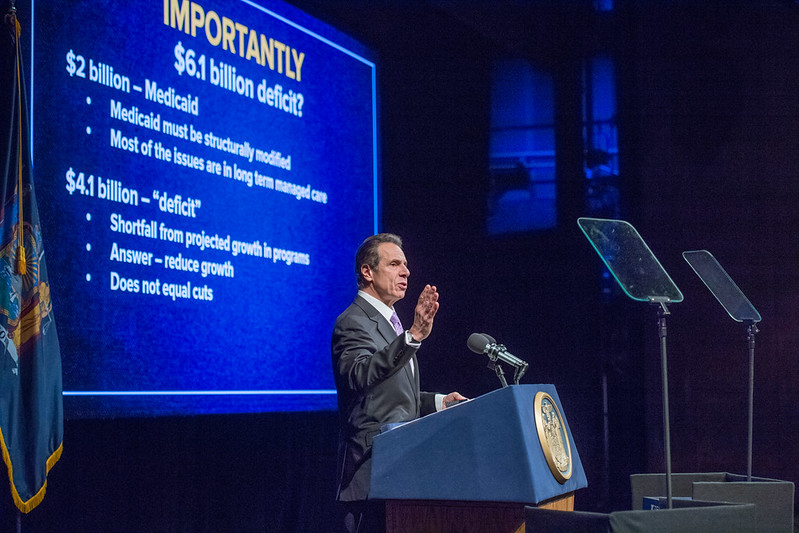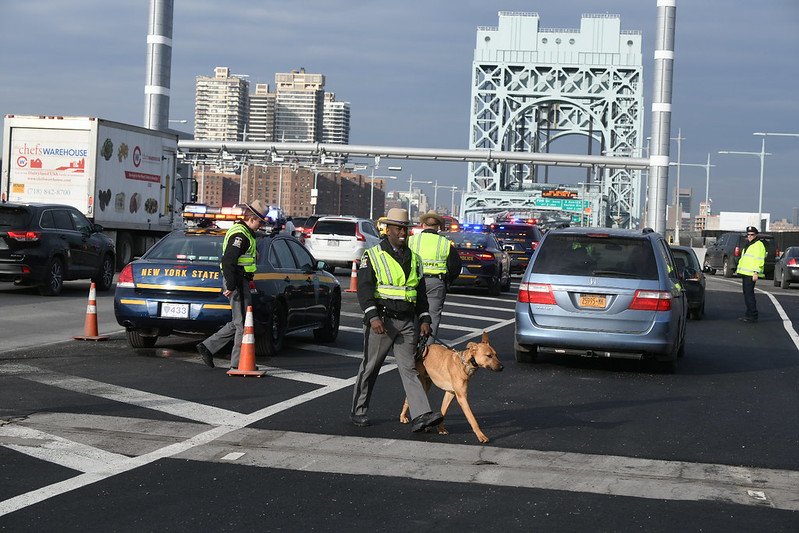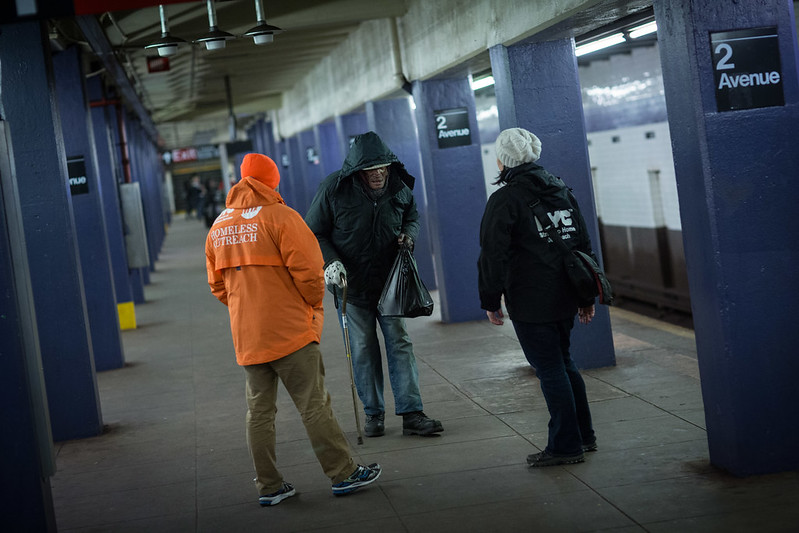Minding the Medicaid Gap

(photo: Darren McGee/Office of Governor Andrew M. Cuomo)
Albany chatter in anticipation of Governor Andrew Cuomo’s 2020 State of the State message was dominated by the prospect of a $6.1 billion budget gap. How to fill it? Tax? Cut programs? All unpalatable.
Of course, budget gaps are nothing new. In an opinion essay published in the Rochester Beacon just three days before the governor spoke, his Budget Director Robert Mujica pointed out that annual “baseline gaps” are routinely closed by controlling spending growth. “Last year,” Mujica wrote, “the baseline gap we closed was $5.3 billion; in recent years it has ranged from $3 billion to $4 billion.”
Three things were new this year though: the gap’s size, its source in a massive area of the budget previously thought to be under control, and its potential for future rapid growth if left unaddressed.
When he finally got to the subject, well into his more than hour-long message, Governor Cuomo attributed the budget gap “largely to our Medicaid cost.” Medicaid in New York will cost $73.8 billion in the current (2020) fiscal year, combining federal and state monies, because Cuomo said, of “federal cuts and…cost increases incurred when local governments were held harmless by the state for Medicaid increases.”
The governor did not mention that New York State remains unique in the nation in the degree to which it required its 57 counties and New York City to help pay Medicaid costs from local source revenues. According to a 2017 National Association of Counties report, “Counties contribute to Medicaid in 26 states. Of these, 18 mandate counties to contribute to the non-federal share of Medicaid costs.” But no state’s counties pay more than New York’s, “$7 billion per year – or $140 million per week.”
Nor did Cuomo mention that the property tax cap, which constrains counties’ ability to meet the costs of their Medicaid share, was enacted at his initiative.
Nor did he mention that this year’s budget gap was widened by rolling forward a far greater amount than usual in state Medicaid spending - $1.7 billion - from the 2019 to the 2020 fiscal year, in order to stay under another cap, the Medicaid Global Spending Cap, created in 2011 by the state to keep these costs in check.
In Cuomo’s first term, and in part of the second, per enrollee Medicaid costs were cut, and then held in check even as the covered population grew by over 1 million people – a stellar achievement by the governor’s Medicaid redesign team. But cost growth resumed in 2017 and thereafter, and absent decisive intervention, is projected to continue growing at an unsustainable pace.
The Budget Division’s mid-year update to the state’s 2020 financial plan attributed Medicaid spending increases to two policy choices: the aforementioned state assumption in the growth of the local Medicaid share and the phased-in increase in the state minimum wage to $15 per hour in some parts of the state, enacted in 2016.
“The FY 2019 State Operating Funds spending increases include over $900 million for the incremental cost of the local Medicaid growth takeover,” the Budget Division wrote, “and nearly $800 million for the direct cost of the minimum wage increase to health care providers,” which is passed along to the state and the localities. While the first was highlighted by the governor in his speech, the second, a key achievement highlighted during the 2018 campaign for governor, went unmentioned.
Medicaid is administered in New York State through the counties and the City of New York. In the governor’s view, now that these localities have less skin in the game, an unintended consequence is that they have less incentive to seek efficiencies. “You cannot separate administration from accountability,” Cuomo said in the State of the State. “It is too easy to write the check when you don't sign it.”
Of course, even with some of the financial pressure relieved, the counties and New York City are still left with a big aggregate obligation; for 2019 it totaled $7.2 billion. Moreover, a major element of Medicaid reform, authorized by law in 2012, has been to “transfer responsibility for the administration of the Medicaid program from Local Departments of Social Services to the [state] Department of Health.” Significant progress in achieving this goal, and plans for future steps, were documented by the state Health Department in a report to the governor and Legislature in December 2018.
Following up in his January 21 budget message this week, Governor Cuomo revealed how he proposes to link writing the check with paying it. The state would continue to cover the increase in local share it had assumed, but only if New York City and the counties stayed annually within the 2 percent property tax cap and limited their yearly growth in Medicaid costs to 3 percent. If they go over this annual growth rate, they would pay the difference. If they went under, they would share the savings. (Cuomo is also empaneling another Medicaid redesign team, tasked with finding $2.5 billion in savings.)
All this assumed, of course, that actual control of the level of spending for Medicaid is in local hands. Even though more and more of the administration of Medicaid, as a matter of state policy, is in the state government’s hands. Even though demand for services might rise because of changing social or economic conditions, entirely outside of local control.
There is another way to cut the Gordian Knot. It is precisely to incentivize efficiency and accountability that reformers have long advocated full state government assumption of responsibility for the Medicaid program. For example, the Citizens Budget Commission wrote in a 2018 report: “It is time for New York to adopt measures that will completely eliminate the required local share of Medicaid.” This very good idea would achieve precisely what the governor is advocating.
Where would the money come from? In many jurisdictions increased sales tax authority was authorized for localities to pay for Medicaid. With no Medicaid obligation to meet, New York City and the counties could be required to relinquish some of this resource.
Thus a big tradeoff: counties would be relieved from responsibility for administering Medicaid and paying any share of the program’s costs. In return, the state would reclaim that portion of local sales tax revenues required to cover localities’ former Medicaid share.
This would fully make one government, the state government, both the “check writer” and the “check signer” for all of Medicaid. And the governor would then have the full control he needs to achieve the economies he thinks possible but unachievable under the current shared responsibility for the program.
***
Gerald Benjamin is director of The Benjamin Center at SUNY New Paltz. On Twitter @TheBenCen.
***
Have an op-ed idea or submission for Gotham Gazette? Email This email address is being protected from spambots. You need JavaScript enabled to view it.
Surveillance and the City: Cuomo's Camera-On-Every-Corner Boondoggle

(photo: Governor's Office)
Even a terrible product can sometimes do some good. That’s the case for automated license plate readers (ALPRs), the disturbingly prolific tracking tool that have propagated across the country. When Grafton Thomas allegedly attacked a Hanukkah gathering in Monsey last December, ALPRs helped police identify him. It was a high-profile win for the increasingly-controversial technology, which has come to track nearly every vehicle in New York City.
Governor Cuomo responded to the news with $680,000 for the town of Ramapo, which contains Monsey, and the nearby Village of New Square to install ALPRs. But his support went even further than that. ALPRs even made an appearance in the governor’s State of the State policy book. There, the governor urged the Legislature to both expand the state’s ALPR system, which was set up starting in 2016, and to begin the process of updating existing ALPRs with more sensitive cameras.
There are no details on where the new cameras might go or how high the tab might run, but costs could easily go into the hundreds of millions of dollars. The problem is that while the surveillance-minded governor is quick to highlight the nightmarish scenarios where ALPRs could be useful, he doesn’t say one word about privacy.
ALPRs are not just invasive, they may soon be unconstitutional. That’s the concern raised by the Supreme Court’s 2018 ruling in Carpenter v. United States, where the high court ruled that it was unconstitutional to track an individual for a prolonged period without a warrant. In Carpenter, the technology was different, but the privacy implications were exactly the same. There, police used cellphone tower data instead of ALPRs to create the digital tracking device.
It’s jaw-dropping to think that the State of New York might invest a small fortune in an arsenal of cameras that it could have to shutter in just a few months. That’s because the type of ALPR system the governor is endorsing only works by tracking each and every one of us. It’s not a targeted search for one person on the run, it’s a constant log of where every car goes. In short – it’s a China-style surveillance state.
If the governor required every driver in New York State to wear a GPS ankle monitor before they were let on the road, it would help in the occasional criminal investigation, but we would recognize that the privacy price is too high. ALPRs may not be as physically painful as an ankle monitor, but the civil rights objections are the same.
But while the risks in ALPRs are clear, the benefits are ambiguous. Governor Cuomo promised that ALPRs would be a “deterrent for future attackers,” but it’s hard to see how. In the horrific attack in Monsey, a man in mental health crisis took aim at the Jewish community. He wasn’t a rational person who would weigh the levels of surveillance before striking out, he was an unhinged individual whose mental illness caused him to commit horrific crimes.
We all want to feel safe. We all want to believe that those in positions of power have the tools to prevent “the next one.” And so well-intentioned politicians feel tremendous pressure to do something, anything to show that they are taking the threat seriously, to show that they are responding. But the truth is that no police technology or surveillance device will be able to predict and prevent anti-Semitism. And we should all know that by now.
In the ‘80s and ‘90s, we were told that we needed draconian prison sentences. We didn’t. In the ‘90s and 2000s, we were told that we needed broken windows policing and stop-and-frisk. We didn’t. Now, we are told that we need omnipresent surveillance and that it’s the only way to prevent hate crimes. It’s not. It’s clear that we don’t need this wasteful surveillance spending. What’s unclear is if anyone can stop it.
***
Albert Fox Cahn is the founder and executive director of The Surveillance Technology Oversight Project (S.T.O.P.) at the Urban Justice Center, a New York-based civil rights and privacy group and a fellow at the Engelberg Center for Innovation Law & Policy at N.Y.U. School of Law. He writes the monthly "Surveillance and the City" column for Gotham Gazette. On Twitter @FoxCahn & @STOPspyingNY.
***
Have an op-ed idea or submission for Gotham Gazette? Email This email address is being protected from spambots. You need JavaScript enabled to view it.
Following Our Faith, Marshaling Our Resources to Solve Homelessness in New York City

(photo: Michael Appleton/Mayor's Office)
It was early evening on a street corner on the Upper West Side. A young woman rushed up to me and asked for money so she could buy some dinner. She was flushed, out of breath, and pregnant. Stories like this are a frequent occurrence for any New Yorker who walks the streets and takes the subways.
This young woman said she’d had a fight with her boyfriend and he’d kicked her out of their apartment. She had just been placed in a shelter and didn’t have supplies or food. Despite my desire, knowledge and connections, I couldn’t solve the complexities in her life that had brought us together. All I could do in that moment was give her enough money to buy a decent meal in the neighborhood. I did, and walked on, deeply troubled both by her situation and by my inability to make a real difference.
As New Yorkers, we have an obligation to do something to help our neighbors who experience homelessness. The question is, how can we make a difference?
Many people on the streets suffer from mental illness and substance use disorders and have histories of criminal justice involvement. Many had childhoods filled with domestic violence, child abuse, family instability, overcrowding, inadequate nutrition, inconsistent education, and poverty. The effects of structural racism make these problems even worse for people of color. Whether or not we give money to people asking for it, we must acknowledge the essential humanity of the person in front of us and support ways to make our society more compassionate, and effectively so.
It’s important to understand how homelessness has become so widespread, despite the dramatic increases in spending that have occurred under successive city administrations. It must be baffling that despite these increases, there seem to be so many people on the streets asking for help.
Some context matters. The number of single adults in shelters has increased by 65 percent in just the past six years. Sadly, this should be no surprise. The number of psychiatric hospital beds in the city has been significantly reduced from 2014 through 2018, and we are laudably moving to reduce incarceration rates (including the closing of Rikers Island, where 40 percent of the inmates have severe mental illness). The shelter system was never intended to be the housing solution for people suffering from serious mental illness – but where else, other than the streets, can they go?
In order to truly make a difference for New Yorkers who are homeless, we should concentrate our energy to make the city’s large shelter and support system fully realize its potential to help homeless people achieve maximum independence. This is in keeping with Jewish teaching, which urges us to ensure that poor people have what they lack in order to attain self-sufficiency.
We need to stop thinking of shelter as a band-aid or emergency. Shelters should be purpose-built with in-house services the clients need most. They should be small enough to be manageable, especially for clients that are severely challenged; and they should be operated by reputable nonprofit providers like mine, that are open 24/7/365, delivering social services, medical care for both physical and mental health, good nutrition, job training, and support to find permanent housing, all with good governance and oversight.
Shelters like these should also be in every community—including yours! Many people are afraid of shelter and supportive housing opening in their neighborhoods. The prophet Isaiah urged that we should take the poor into our homes; this teaching was deemed so central that it is read every year on Yom Kippur. In our day, we can enact this mandate by committing to be vibrant communities that care for all members.
You can become involved by getting to know the nonprofits that operate in your community, and the people that run them. You can participate in Community Advisory Boards that meet regularly with nonprofit operators. You can volunteer, join a board of directors, and if you don’t feel comfortable giving handouts on the street, commit to providing ongoing financial support to the nonprofits that provide services.
I invite you to join me on Sunday, January 26, for Reconstructing Judaism’s New York Day of Learning: Jewish Response to Homelessness in the New York Area. We’ll discuss how Jewish texts and values can guide both individual response and public policy, and explore how we can accomplish systematic change.
I often think of that pregnant woman I’d met and hope that she and her child are now in better circumstances. What I know is that if we invest in shelters and affordable housing, and consider them communal responsibilities just like local hospitals and schools, we can make that crucial difference for people like her. No, we won’t eliminate homelessness, but we can help each and every person who is homeless find the right path forward for them. As we read in Pirkei Avot, a collection of rabbinic wisdom dating to the third century, “You are not obligated to complete the work, but neither are you free to desist from it.”
***
Eric Rosenbaum is President and CEO of Project Renewal, a leading New York City homeless services agency, and is also a board member of Reconstructing Judaism, the central organization of the Reconstructionist Movement. On Twitter @reconjudaism.
***
Have an op-ed idea or submission for Gotham Gazette? Email This email address is being protected from spambots. You need JavaScript enabled to view it.




